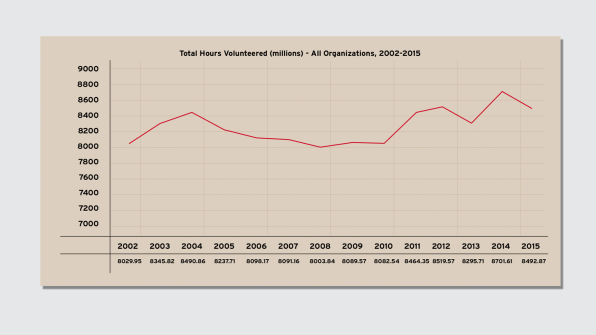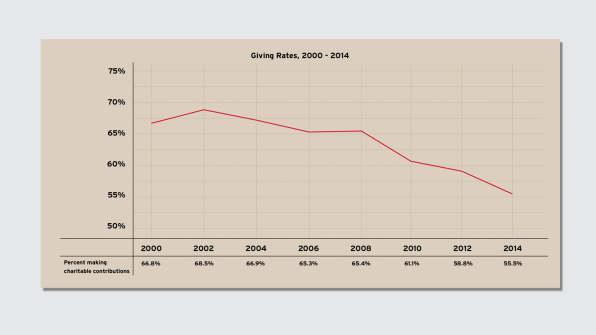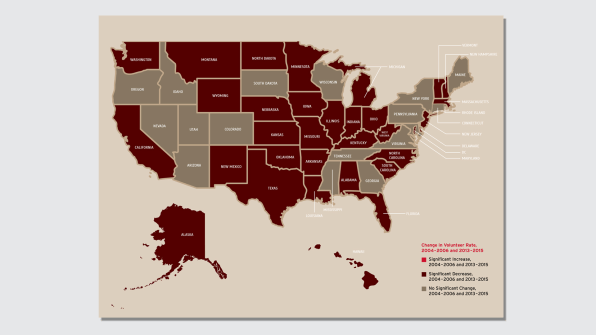Charitable donations are at a high point–but fewer people are giving
Here’s a statistic that many people in need might feel thankful about this holiday season: Americans are giving record amounts to charity, and volunteering more time than ever. But it’s not all Americans. In fact, it’s fewer people than ever–they’re just doing a whole lot more than everyone else.
“The amount of dollars and the number of volunteer hours is hitting historic highs, and at the same time we’re hitting historic lows in the percentage of Americans who are actually giving and volunteering,” says Robert Grimm, director of the Do Good Institute at the University of Maryland. So maybe everyone should just be grateful there are super charitable folks around to pick up the slack.

Or maybe not. “That’s masking an unsettling trend, which is less and less Americans are actually engaging in their communities every year,” he says.

A new Do Good Institute report that Grimm coauthored explains the dangers of this particular philanthropic paradox. Americans gave a record total of $410 billion in 2017, and about 8.5 billion in cumulative hours to various causes in 2015–the most recent year that data was available. But in recent years, only an estimated 56% of Americans donated annually, far less than the 67% that did so at the turn of the millennium. Just under 25% of Americans volunteered regularly, which is also less than the national peak of about 29% shortly after 9/11.
While a variety of factors (including, quite possibly, being overwhelmed at the broad range of need in the country today) might explain this stratification in giving, economics could also be a cause. In the U.S., wealth is increasingly concentrated at the very top of the socioeconomic spectrum, while many working-class people have not seen their wages or wealth grow in the last several decades. Perhaps, fewer people are giving money and time because they simply have less of it. Tellingly, in 2017, 52% of donations came from households earning over $200,000 per year.
As Grimm sees it, the division in giving reflects other rifts in American culture. “When less residents [within a community] are actually engaged in behavior such as giving and volunteering in particular, there’s greater social isolation and less trust in each other,” he says. “There’s a good deal of research that shows that regularly engaging in these kinds of charitable behaviors results in greater physical and mental health,” Grimm says. Participating in causes and volunteering brings people together, and as people opt out of doing these things, they miss opportunities for connection around common goals.

Similarly concerning is the effect these trends may have on charitable organizations themselves. Many nonprofits may just be looking at their bottom line or top volunteers, and not realizing that they’re spread thin. The fewer key contributors or supporters you have for your cause, the less stable your organization is if several unexpectedly disappear.
The Do Good Institute’s findings come from an analysis of the U.S. Bureau of Labor Statistics and Census (BLS) data of 55,000 households between 2002 and 2015. This covers 215 metro areas across all 50 states. Volunteer-wise, the decline is particularly steep in rural areas and the suburbs–places that were once thought of as bastions for social support.
Obviously there are outliers, but here’s what the average American giver looks like: Most Americans who volunteer do so for about two hours a week, according to BLS data. The average donor contributes about $2,500 annually, according to Indiana University. In short, if a whole bunch of people just gave a little more instead of nothing, they’d help a lot more people, and probably make their own life feel more complete.
To that end, Grimm suggests that more communities think about how to instill generosity as a value in their own kids, so that giving becomes a lifelong habit. He thinks many nonprofits need to work harder at keeping supporters engaged year-round, not just during the holidays, and that social entrepreneurs recognize the inherent value of founding more nonprofit and civic startups.
Either way, Americans may want to consider the benefits of sustained charitable engagement over time. “If you exercise, once a month, you’re probably not going to experience a lot of health benefits,” Grimm says. “It’s very similar if you volunteer once or twice a year.”
(23)



